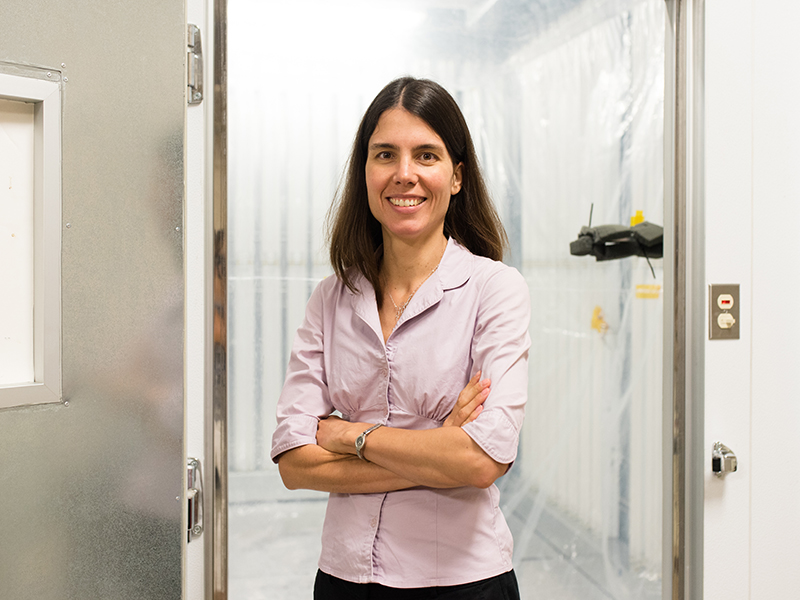Nation’s Largest-Ever Indoor Air Quality Experiment Coming to ‘UTest House’
In the developed world, human beings spend the majority of their lives indoors. Whether we are working, relaxing, cooking, cleaning or sleeping, it’s estimated the average person will spend 90 percent of his or her time in an indoor environment. Yet little is understood about how chemical compounds indoors interact and transform throughout our daily lives.
This summer, the country‘s largest indoor air quality and surface chemistry experiment — hosted by researchers in the Cockrell School of Engineering at The University of Texas at Austin — brings leading experts to the university’s J.J. Pickle Research Campus to participate in an unprecedented initiative aimed at identifying the key causes of indoor air pollution.

The monthlong project, called HOMEChem (House Observations of Microbial and Environmental Chemistry), incorporates measurements from more than 15 research groups from 13 universities. Experiments are taking place inside UT’s one-of-a-kind UTest House facility.
Working in a variety of fields including engineering, chemistry and microbiology, the experiment will be on a scale never previously attempted and will involve an unprecedented number of institutions and disciplines. HOMEChem is being funded by the Alfred P. Sloan Foundation’s Chemistry of Indoor Environments Program.
Teams from participating schools have set up trailers around the UTest House, equipped with some of the most sophisticated instruments available to measure a large spectrum of components in air and surface chemistry, from hydroxyl and nitrate radicals to secondary organic aerosols.
Measurements will continue being made throughout June while experiments are also being conducted within the UTest House to simulate normal human activities, such as cooking and cleaning. The team will also host a large social gathering where approximately 12 people will gather in the house to replicate a holiday dinner as a means to assess the impact of human occupation on indoor air quality and surface chemistry.
While researchers from the University of Colorado Boulder and Colorado State University are leading the organization and planning of the overall HOMEChem project, faculty members in the Cockrell School’s Center for Energy and Environmental Resources are serving as the hosts of the experiments. Not only are they sharing their expertise, they are also providing high-tech measurement equipment in addition to the UTest House facility itself.
Lea Hildebrandt Ruiz, assistant professor in the McKetta Department of Chemical Engineering, is one of three key players from Texas Engineering who have put this project together. The other two professors are Richard Corsi and Atila Novoselac, both in the Department of Civil, Architectural and Environmental Engineering.
“The UTest House — which was conceived, designed and retrofitted by Texas Engineers — really is the ideal structure to conduct the unprecedented HOMEChem project,” Hildebrandt Ruiz said. “While much of the attention has been focused on outdoor air pollution, many engineers and scientists have devoted their careers to better understanding the factors affecting indoor air quality. I am excited to join my colleagues and other leading experts on this first-of-its-kind project.”
The study has obvious implications for the indoor air quality research community, but its findings could also have implications for other fields, such as medicine.
“This study will lend important insights into home conditions that promote the formation of oxidant chemicals and organic compounds, which are implicated in health effects across a range of organ systems, including the lungs, the cardiovascular system and the brain,” said Dr. Elizabeth Matsui, a professor of pediatrics at UT’s Dell Medical School and a national expert in childhood asthma. “The results will help us better understand how to reduce these exposures, which will provide a foundation upon which to develop population-level strategies to reduce indoor exposures, with the ultimate goal of reducing disease burden and improving health across the population.”
The HOMEChem team will host an open house for members of the media, academics and industry partners on June 22 at the J.J. Pickle Research Campus. Other institutions involved include the University of California, Berkeley; Indiana University; the University of Toronto; Syracuse University; Drexel University; and the University of California, San Diego. In addition, researchers from Harvard University, the University of Massachusetts Amherst, Washington University in St. Louis and the College of William & Mary are also participating. Industry partners include Picarro, Airmodus, Handix Scientific and the IAQ sensor company.
